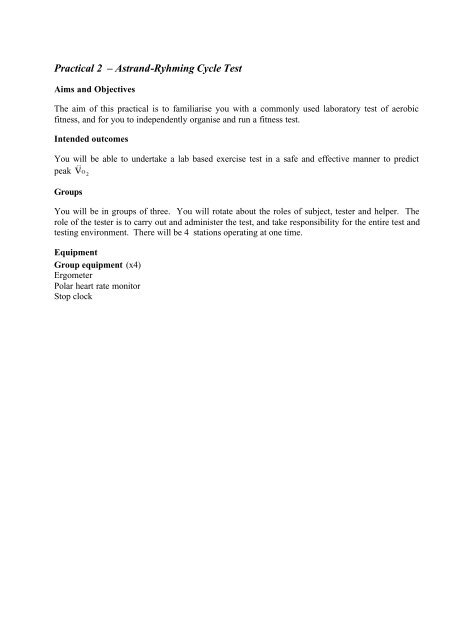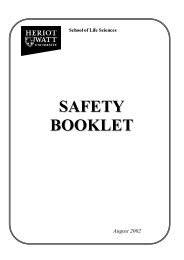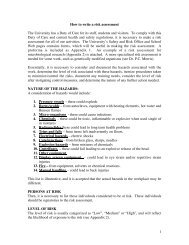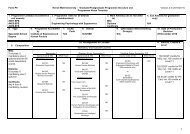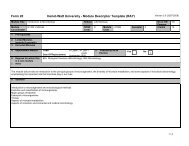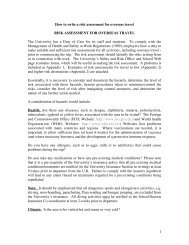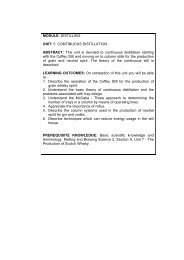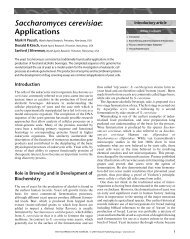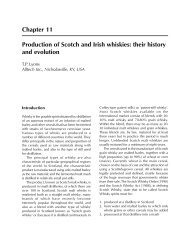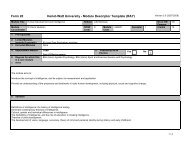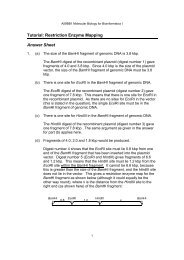Astrand Rhyming test
Astrand Rhyming test
Astrand Rhyming test
Create successful ePaper yourself
Turn your PDF publications into a flip-book with our unique Google optimized e-Paper software.
Practical 2 – <strong>Astrand</strong>-Ryhming Cycle Test<br />
Aims and Objectives<br />
The aim of this practical is to familiarise you with a commonly used laboratory <strong>test</strong> of aerobic<br />
fitness, and for you to independently organise and run a fitness <strong>test</strong>.<br />
Intended outcomes<br />
You will be able to undertake a lab based exercise <strong>test</strong> in a safe and effective manner to predict<br />
peak V O<br />
2<br />
Groups<br />
You will be in groups of three. You will rotate about the roles of subject, <strong>test</strong>er and helper. The<br />
role of the <strong>test</strong>er is to carry out and administer the <strong>test</strong>, and take responsibility for the entire <strong>test</strong> and<br />
<strong>test</strong>ing environment. There will be 4 stations operating at one time.<br />
Equipment<br />
Group equipment (x4)<br />
Ergometer<br />
Polar heart rate monitor<br />
Stop clock
The <strong>Astrand</strong>-Ryhming Test - Introduction<br />
The <strong>Astrand</strong>-Ryhming <strong>test</strong> was developed in 1954 based on the response of 58 subjects aged 18-30.<br />
It is based on the assumed relationship between V O<br />
2, work rate and heart rate. <strong>Astrand</strong> and<br />
<strong>Rhyming</strong> found, when working at a load that required 50% of maximal O<br />
2<br />
consumption, that the<br />
heart rate for a group of healthy male subjects averaged 128 after 6 minutes of work (<strong>Astrand</strong> and<br />
<strong>Rhyming</strong>, 1954). The corresponding heart rate for female subjects was 138. When their subjects<br />
worked with a heavier load, thus demanding an oxygen consumption of 70 percent of their aerobic<br />
capacity, the average heart rate was 154 for males and 164 for females. The standard deviation was<br />
8 or 9 beats per minute. <strong>Astrand</strong> and <strong>Rhyming</strong> used these data to develop a nomogram for<br />
predicting maximal O<br />
2<br />
consumption from heart rate for one 6 minute submaximal work load. They<br />
fond that the accuracy of prediction varied with the level of the work load selected. On the bicycle<br />
ergometer at 900 kilograms meters per minute (kpm’s), the standard error of prediction for men<br />
was plus or minus 10.4 percent and at 1200 kpm’s it was plus or minus 6.7 percent. The author<br />
found a correlation of .74 between predicted maximal O<br />
2<br />
consumption as measured in the<br />
laboratory.<br />
Protocol<br />
The seat height should be appropriately adjusted for the subject (The correct seat height for<br />
subjects of cycle ergometry is achieved when there is a slight bend of the knee as the ball of<br />
the foot rests on the pedal at the bottom of the pedal stroke).<br />
The subject is prepared for the <strong>test</strong> with a 3-minute submaximal warm-up involving<br />
pedalling at 60 rpm on the ergometer using a low resistance followed by some stretches of<br />
the appropriate muscles.<br />
With the subject wearing the polar heart rate monitor, check that a signal is being suitably<br />
received.<br />
The initial work load should be set at 60W for females and 120W for males.<br />
On the command, the subject begins to pedal at 60rpm. The subjects heart rate should be<br />
observed throughout.<br />
Record the heart rate at 5 minutes and 6 minutes. If the mean heart rate is between 130 and<br />
170bpm, the <strong>test</strong> can be terminated. If the mean heart rate is less than 130bpm, increase the<br />
work load by 60W, and continue the <strong>test</strong> for a further 3 minutes. If the mean heart rate<br />
between minutes 8 and 9 is between 130 and 170bpm, the <strong>test</strong> can be terminated, and so on.<br />
When the <strong>test</strong> is completed, reduce the resistance, and continue pedalling for 3 minutes.
Calculations<br />
Use the <strong>Astrand</strong>-Ryhming nomogram (see below) to estimate V O<br />
2<br />
max. Draw a line between the<br />
mean heart rate during the last two minutes of the <strong>test</strong> and the final work rate. Multiply the<br />
predicted V O<br />
2<br />
max by the correction factor for age or known maximum heart rate.<br />
Results<br />
Date: ________<br />
Weight (kg): ________<br />
Age: ________<br />
220-age ________<br />
Age correction factor: ________<br />
Ending workload : ________ Ending heart rate: ________<br />
Predicted V O<br />
2<br />
max ________(L/min)<br />
Predicted V O<br />
2<br />
max ________(ml/kg/min)<br />
Reference<br />
ASTRAND, P. O. & RYHMING, I. (1954). A nomogram for calculation of aerobic capacity (physical<br />
fitness) from pulse rate during sub-maximal work. Journal of Applied Physiology 7, 218-221.
Questions to be answered/Discussion Points<br />
What populations and settings do you think this <strong>test</strong>s may be most suitable for<br />
What assumptions is this <strong>test</strong> based on<br />
What limitations may there be for this <strong>test</strong><br />
Comment upon the validity, reliability and repeatability of these exercise <strong>test</strong>s<br />
What are the sources of energy for this <strong>test</strong>s<br />
What should be the duration between <strong>test</strong>s


